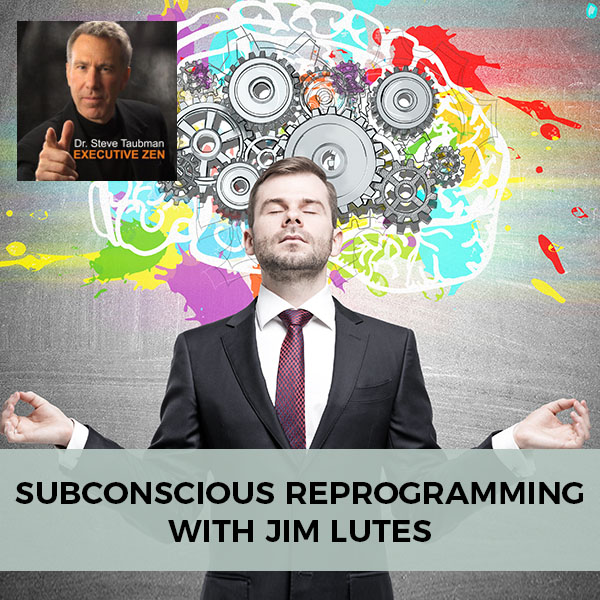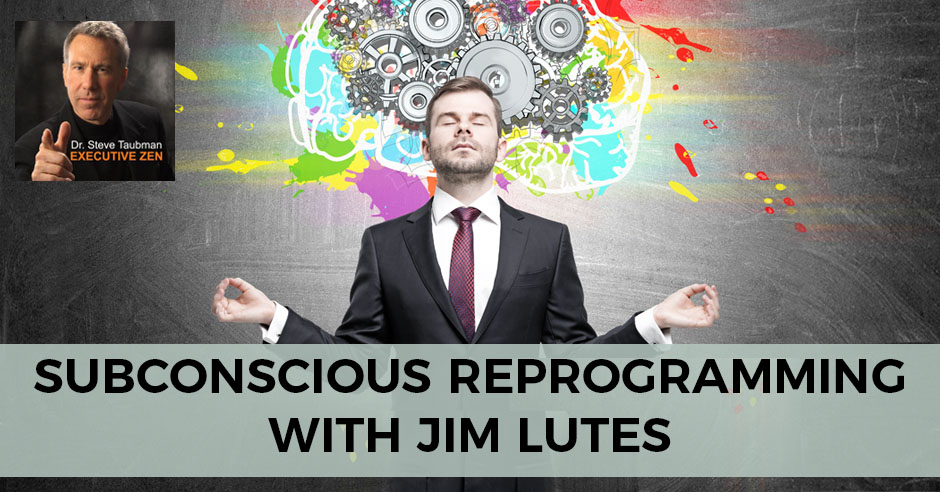

In this episode, I get to discuss one of my very favorite topics with a true master of the field.
Jim Lutes has accelerated the careers of top entrepreneurs through his personal growth and subconscious reprogramming workshops worldwide. Since the 90s, Lutes International has been a respected training company, drawing audiences from corporations, sales forces, individuals, and athletes.
This guy knows his stuff…and he and I speak the same language! This episode exemplifies the Executive Zen philosophy; awaken your mind to greater capabilities through a better understanding of how your brain works…and how to maximize its function! 🙂
—
Listen to the podcast here:
Subconscious Reprogramming with Jim Lutes
We’re talking about reprogramming your subconscious mind. I’ve got a guest with us who is an expert in that area, a friend and a colleague. This is a topic about which I am particularly excited. For those of you who know me and know my work, you realize that the vast majority of what I do falls under the heading of subconscious reprogramming. What can we do to gain mastery over our subconscious mind? When I say our subconscious mind, that may sound a little bit vague for some of you if you’re not steeped in psychology as I am and many of my colleagues are. Sometimes it sounds vague as to not be meaningful, but the reality is that we do in fact have both a conscious and a subconscious mind. It simply means that there are parts of your mind that are within your conscious awareness.
You know what you’re thinking at this moment and therefore, it is conscious to you. However, there are many things you’re thinking that you’re not aware that you’re thinking. It’s like a background program, the operating program that drives the computer that is your brain. It is unfortunate that the vast majority of our beliefs, our attitudes, our sense of self, our capacity to succeed in life exists below the conscious surface. We are constantly operating within a very small frame, a small track that from our perspective seems very real, seems very logical. It seems very natural for us to be doing what we’re doing, deciding what we’re deciding, choosing what we’re choosing as if that was the only thing that was to choose, and yet choices are infinite.
We have many different ways that we might choose to move forward with our lives. We have so many different goals we might set, so many different choices of interpretation of experiences in our life. For example, that guy who cut you off on the highway on the way to work, that guy might be a jerk or he might be somebody who has a very strong need to get somewhere quickly or it might be your uncle Max. Depending on which it is in your mind, not in reality, but in your own mind will determine how you respond or react to the stimulus. We’re constantly being bombarded by stimuli, by things happening in our lives, challenges that we need to meet. When we are bombarded by those challenges, the decisions we make, the choices we make, the actions we take are more often than not taking place so quickly and so automatically. We seldom stop to think that it is the subconscious programs that we’ve never even questioned, that are affecting our outcomes.
Within each of us is a conscious and a subconscious mind. Click To TweetI have a commitment to the Executive Zen show to provide material that is relevant and that’s practical. We’re not going to keep this in the realm of mere theory, but rather in a very practical sense. What can you do as an employer, as a leader to influence how people begin to reprogram their own subconscious mind to elevate their number of choices? I’m a hypnotist and I use hypnosis as a tool for that purpose. Naturally, I use it for fun too but that’s only in order to wake people up and open their eyes to the reality that within each of us is a conscious and a subconscious mind. When we can, through tools and techniques that we teach, allow someone to become quite enough, silent enough, and mindful enough to get out of their automatic stream of thought. They become capable of reprogramming.
Reprogramming those subconscious beliefs, those beliefs that might include fear, anxiety, insecurity, any number of things that influence how well we get to do what we do. Implementation is something that you as a leader have to be thinking of. Inspiration and information without implementation lead to depression and they lead to low numbers and bottom lines that don’t shine. When you’re in the process of training your team, when you’re coaching them, when you’re bringing in teachers, keynote speakers, trainers and whatnot, if you haven’t cracked the code, if you haven’t figured out how to shift the subconscious mind, then a lot of what you’re teaching them is bouncing off of a solid wall. If it’s bouncing off a solid wall, you can be sure that you’re wasting a lot of money and you’re not getting the results you want.
If you could learn some of the secrets of the hypnotist, of the subconscious trainer, you can start to have those new talents, those new skills implemented. One example is something that we do in the network marketing world we call the 21-day challenge. It’s where we provide an audio recording, which is a guided hypnosis or a guided meditation that reprograms the subconscious mind of those listening to it so that over the course of 21 days, while they’re being given certain challenges, they are also being given brain food, a new way of thinking. The subconscious mind at the deepest levels begins to resonate with a new paradigm, a new belief system.
People come to believe that they are capable, that they are fearless. People do want to hear what they have to say. That operating at a high level of consistent action is desirable rather than sitting around being lazy. The 21-day challenge is a perfect example of that. In our work, we’ve logged 47% increase in productivity in several companies using that very technique. Some of you might have also seen my hypnosis shows in which I’ve motivated people through hypnosis. Quite often, what I’ll do just for fun is to take one of my subjects in a hypnosis show and have them believe, while hypnotized, that they are the motivational speaker that everybody came to see. What will happen is that person will hop up out of their chair and give a motivating, inspiring and heartfelt speech never realizing that they don’t know how to do it.
Having eliminated the subconscious programming that tells them that it’s not okay, that you can’t do that, you can’t go there, you’re not good enough. We get to see these things in a very real way. Conversely, in a hypnosis show, I often help people find themselves stuck in their own chair or forgetting their own names. If you believe you can’t do it, you can’t remember your name, you can’t get up out of the chair, then you can’t. If you believe you can give a motivating speech then you can. For you as an employer, this is a practical matter. You need to be thinking in terms of how to turn your human resources into a pool of not just potential but kinetic energy, people who take action.

Subconscious Reprogramming: When we reprogram our subconscious mind, we become capable of things that we did not realize we’re capable of.
Most people don’t believe this, but my experience as a hypno coach is remarkable. I’ve worked with people with cancer and helped them to fight their malady, if nothing else, to make them feel healthier and better and get them out doing exercise. Sometimes, even without making any major claims, it shifts the outcomes of their illness because we have a body-mind connection. Changing the subconscious has profound power. There are many research projects that speak to that. I’ve worked with people with bad relationships and bad paradigms about relationships. They make the wrong decisions again and again, reinvent the same bad relationships again and again, and yet when we reprogram their subconscious mind, they are capable of things that they didn’t realize they were capable of. People often don’t know what they don’t know. They don’t realize the automatic behavior of their own minds.
We often say that we’re like fish swimming in the water. The fish doesn’t see the water because it’s all around them. We don’t see our thoughts, they’re all around us. They are subconscious. They are unexamined. We need to help people examine and reprogram the subconscious mind. You’ve got to start thinking in terms of what that means in your business. Are your employees hypnotized? Are they programmed to believe things that stop them from taking action? Having said all that, I will be speaking with someone that many of you know and admire. He’s one of the nation’s leading personal development teachers and a great guy. Make use of what you hear now because inspiration and information without implementation is a waste of time.
—
I am thrilled to be introducing my guest. Say the name Jim Lutes and chances are the top performers in your company has attended one or more of his dynamic trainings over the last few years. He’s taught his branded form of human performance since the early ‘90s. He has an accelerated growth program. He has accelerated the careers of top-level entrepreneurs by conducting trainings on personal growth and subconscious programming in worldwide markets. During this last twenty some odd years, Jim took his skills regarding the human mind and combining it with training on influence, persuasion and communication strategies. He launched Lutes International in the early ‘90s. Jim is based in San Diego. He has taught seminars for corporations, sales forces, individuals and athletes. He’s appeared on television, radio, and worldwide stages.
As you’ll find Jim’s style, his knowledge and his effectiveness are quite profound and he gets great results. One of his quotes from one of his followers says, “Jim Lutes possesses a unique ability to create a performance change in an individual in the fraction of the time it takes his competitors.” The core of human decisions are based on programs we acquire, reinforce and grow. Combining Jim’s various training, an individual can reach new levels of achievement and fulfillment in all areas of life. I got to meet Jim face-to-face through a mutual friend by the name of Erik Swanson. Jim, by the way, I wanted to let you know that I spoke with Garrett McGrath, who wishes you his love. Everybody, please welcome, Jim Lutes.
Steve, thanks for having me. I feel like I’m speaking to my brother from another mother here. We have a lot in common, a lot of parallel paths that we walked down.
The other thing is Jim Britt, that’s the other connection. I had spoken in Manila in the Philippines and shared the stage with Jim Britt who is a business partner of Jim’s and they do seminars together. Jim Britt was one of the folks who help launch Tony Robbins’ career. We share some pedigree and it’s pretty wonderful. Where have you been lately, Jim?
I’ve been in my hometown of San Diego, California. I have the distinct moniker of being the only native. As I walked around, everybody can’t believe that I’m actually from here and I’m still here. I’m putting a lot of things together. As we move through our careers in our lives, through the different stages of life and the different stages of career, our goals shift, adjust and modify more toward on what footprint am I going to leave when I leave? It becomes more relevant as we gain in the years a little bit.
We choose as if we only have one choice and yet, choices are infinite. Click To TweetDon’t you think that early on in our lives we’re pushing for the big box or whatever and it’s great to be highly successful but it becomes about legacy? It becomes about making an impact and it becomes about integrity.
Yes, it does. Especially, when the world that we’re in because we’re in a constant state of massive interaction, whether that be using technology or face-to-face. When you’re interacting at that level or that quantity of individuals, you have to be aware and conscious that you can change individuals with a simple conversation. Coming from an individual mentor standpoint, they may not ask you permission for their mentorship but there may be that moment, that catalyst in your interaction skills and your communication skills and your ability to translate complex ideas to an individual that can change them just simply with a conversation. That happened to me when I was a young man. I was sitting on the wall in the Pacific beach and a gentleman sat down and said, “What are you doing? How’s it going?” I said, “Pretty good. I’m just watching the girls walk by.” He goes, “Then what?” I go, “I’ll watch them walk by the other way.”
I asked him what he did and he said, “I’m an entrepreneur.” I said, “I didn’t know what that was.” The way this conversation became the catalyst to springboard my career was he said an entrepreneur dictates where their body goes 365/24/7. My brother was a PhD, my father was a businessman, and they didn’t have that freedom. They were stuck into an hour lunch. I became very enamored from that brief five, ten-minute conversation. I was meeting somebody who was truly free that dictated where his body goes. He began to talk to me. I asked him, “How do you do that?” He said, “First, you build yourself.” He gave me all the classic books to go get, Think and Grow Rich, The Magic of Believing, Wallace Wattles and all of the classics. I devoured them.
I had found my calling and my area of interest. As fate would have it, I went to La Jolla, to a party and there was a hypnotist there. The hypnotist kept referencing the subconscious mind. It was the most amazing thing I had ever seen in my life. At that moment, that was what I was going to do for the rest of my life. I was going to become one of the best out there. That was when a tennis pro swung his tennis racket for the first time perhaps. There was something about that modality, something about the intrigue that that was the skill set I wanted to master and bring into my career. You never know what conversation can take a person down a completely alternate path.

Subconscious Reprogramming: You just never know what conversation can take a person down a completely alternate path.
How old were you at the time, Jim?
I was 27.
I always think that we all have a target year. I always felt like mentally I’m 33. When I was twenty, I thought 33 and now I’m 62, I still think 33.
The world’s changed. I live in a high rise in downtown San Diego and there are all different age groups in this place. It’s changed quite a bit because I don’t refer to people as young man or son like my parents did. I even get a fist bump when I get in the elevator. There’s not that segregation like they used to. At least in this town, there’s not. I have friends who are 22, 23. I have friends that are 80.
I love the way the story started with a simple conversation and you’re right because a lot of my audience are leaders or executives and whatnot. A lot of them would take issue with this idea that a single conversation can make a profound difference because they’ve been beating their heads against the wall with some of their employees for the longest time saying, “I’ve told you once, I’ve told you a thousand times.” It’s like how is it possible that something as simple as a single conversation could shift somebody’s trajectory?
I think that that individual, in this case being me, was at a high level of receptivity. I was automatically sitting there probably wondering subconsciously and consciously where I was going to go, what career path I wanted to carve out for the rest of my life. Whether we look at it as a universal intervention, whether we look at it as my subconscious creating a dominant thought that ultimately pulls in that individual to sit down beside me, all those are distinct possibilities. Whatever decision we make on why that happened, the outcome is the same. I always tell in my persuasion, influence training that you’re not looking for somebody who needs what you have. You’re looking for somebody who wants what you have. Through communication strategies, you can convert a need into a want. Once that want is there, you just fulfill whatever it is they want.
If I were to walk outside, I can find a lot of people that need to exercise. Just look at them and you can tell that they need to exercise, but they don’t want to. For me to try to fill my gym with people who need to exercise will be an exercise in futility. I need to go find the individuals who want to. It’s easy to convert that and I think a lot of people have such superfluous conversations when they’re out. I was out and I was talking to a gentleman from Boston. He remarked that I was a very interesting person because I want to leave that footprint on it. He was interesting as well but we just didn’t talk about superficial things. We dove into more of a meaningful conversation which creates a memory on that person’s mind as well.
You for sure, you have such a depth of knowledge that it’s a travesty to not convey some of that knowledge to an individual, even in simplistic terms. Everybody is looking to springboard to the next step, whether they’d be going through a tumultuous relationship, financial or health. I know that was interesting in your dialogue in the beginning that you referenced the subconscious mind as it relates to the physical body. I have a division of my company called Mind Healing International and it was spawned from my own personal experiences. I’m a product of my own product as I’m sure you are as well. Previously, I had some challenges with my health.
Inspiration and information without implementation is a waste of time. Click To TweetI’ve never been sick a day in my life. I’ve never smoked, I’m not overweight, I eat right, I juice, I take supplements and I work out. It’s amazing that something would come along and hit me. Within an eight-week period, I had a brain surgery, a massive heart attack and heart surgery. I’m fine now and the doctors are amazed, but I did whatever protocols had to be done and then supported them alternatively. That was a testing ground. It was a proving ground for me to spend a large amount of time in my own subconscious and create a state of physical health and overcome things that were life-threatening.
Now, I’m in perfect health and everything’s great. I was speaking to a gentleman about that. He was in disbelief of the mind-body connection and it’s because they don’t understand the subject matter. Look at psychosomatic pregnancy for instance, where a woman believes she’s pregnant. She’s self-programmed her subconscious to that level of belief. Her breast change, her hormonal profiles change or her menstrual cycle changes. She’s not pregnant. She just thought she was. If the mind can create that level of physiological change in the body then certainly, it can create a sustainable migration toward optimal health, regardless of what happened to you.
We know that there are a lot of people out there who don’t embrace that reality. You and I happen to be people who are pretty sane and practical people. We’ve got research to back this stuff up and including our own experience. It would be wise for the readers to at least embrace that possibility. The mind-body connection is so powerful. We create psychosomatic illnesses, psychosomatic pregnancy. One of the things you’re talking about was that you happen to be receptive and that you might have even somehow magnetized somebody to you to help you hear what you needed to hear.

Subconscious Reprogramming: Body connection is so powerful.
We do that, whether it’s metaphysical or the fact that we’re more open. Sometimes I’ll see the same people day after day and then one day, I’m in a receptive mood and end up having a conversation and finding out that they’ve got an answer to a question I’ve been asking myself. It’s just about being open and receptive. I wanted to highlight that point that you made. You also brought up the issue of wants not needs and that spoke to me. This idea that there are a lot of things we need, but to be able to convert those things to wants. People want to lose weight. They want to exercise and be more engaged in their jobs. They want to go out and beat the bushes and find new clientele. That won’t happen through pure need, even if people feel like they need to do it so they keep their job. They’ve got to do more. They’ve got to stay more in the wanted place. You said that it’s about communication strategies. You as a leader can learn how to communicate with people in such a way that they can change their needs to wants.
I believe that in communication, everything you want, higher power removed, has to come from another individual. Whether it be the computer that I’m on or this phone, this cup of coffee, the pants that I’m wearing, everything came from somebody else. Communication becomes that omnipotent social lubricant. It allows you to move life through life with much more flow and much more effortlessly. Spend time learning to communicate on two fronts. Communicating with yourself is the catalyst for programming yourself. What is your self-dialogue? It becomes a self-fulfilling prophecy through self-affirmation of thought. You’re programming yourself through your own internal communication, but you’re influencing others through your external communication. The ability to learn how to communicate, not unlike somebody learning to work out in the gym, is paramount to moving through life. Everything is a decision and decisions could be reversed, thrown out, changed and modified by some individual because it’s a decision.
Once you learn to effectively communicate, and that comes with the duality of learning how other people receive. A simple example is a direct and indirect communication. It’s interesting because somebody will receive indirectly but communicate directly or conversely, they’ll receive directly and communicate indirectly. I’m a person who would receive indirectly. I don’t respond to commands that well. If I was at your house, Steve, and you said, “Jim, isn’t it a little cool in here?” I go, “Let me close the window.” That was an indirect communication to get me to go up and close the window but if you said, “Jim, close the window.” I’ll say, “Steve, were your legs broken? How can’t you go close it?”
When you look in the context of relationships, some people received directly. Let me give you that example. If I said, “Mary, can you close the window?” She goes, “I’d be happy to,” but if I asked Mary, “Is it cool in here?” She would just give me a, “Yes, it is,” because she wouldn’t connect to that to the action. Once you understand how people receive, then you’re able to communicate in a much more influential, persuasive manner with that individual. It’s interesting and it’s very simple to do. I know that you and I both share advanced strategies of communication, suggestive language, hypnosis, neuro-linguistic programming, psychosomatic synthetics and all the rest of it, but simply being aware of how those people communicate and receive will elevate your persuasive capabilities by at least 30%. Just understanding how they received that conversation and you see this often in relationships.
You’re programming yourself through your own internal communication but influencing others through your external communication. Click To TweetIt’s a groundbreaking piece of data for people. If I’m a leader or even a colleague of other people in my business and I want to improve my relationship with them and improve my persuasive capacity. I understand that I may communicate directly or indirectly, depending on the kind of person I’m speaking with and what kind of results I’m likely to get based on who they are. I also know that he with the most choices wins. If I’m the kind of person who always communicates indirectly, that means I have to shut out half the population. By becoming better at this, that means being somebody who can choose like, “Now, I’m going to communicate directly with this person. This other person I do it indirectly with depending on who they are.” How do I know who they are? What do I look for if I want to improve my communication skills and my ability to persuade?
You’re going to set your groundwork simply by giving an influential suggestion or communication. You’ll see their response and then, you’ll know from that point forward. If I were to say, “Mary, is it cold in here?” and she goes yes, I automatically know she receives directly. From that point, I can craft my conversation. It’s a test. I’m just going to use an example during the dialogue to calculate how they receive or how they communicate. From that point, I probably would have some in a game that I’m looking for, whether that be in a business negotiation. Certainly, if I’m working with employees, I want to make sure that once I opened that line of communication, that conduit to where I understand how they receive then, I’m able to put whatever strategies, tactics, information and training down that pipeline, through that into them knowing that I have a higher level of receptivity. You said something at the beginning and I use a similar statement. I use acquisition, assimilation and application, which is basically saying the same thing you said in a different way.
If you default on any of those, you’re dead in the water. First, you have to acquire the information. We see people do that. We see budding entrepreneurs these days on Facebook and they’re researching. They’re always getting ready to get going. They’re in a constant state of as soon as where they’re stuck in the creative mode. They’re acquiring all this information but because of the overwhelming amount of information and the ease of accessibility, are they really assimilating any of it? Not really. That’s why schools have tests to see if you’ve assimilated the information. These days, people are swimming on the surface of the sea and they’re not delving in, assimilating and learning the information because they’re often doing the next thing. They’re never really learning.

Subconscious Reprogramming: People are swimming on the surface of the sea. They’re not really delving in, assimilating, and learning the information.
Now you’ve learned it, you need to apply it. When you apply it a lot of times those fears come up. Probably the most common ones I find in all the years I’ve been doing this is the need for approval and fear of criticism. Those are the biggest. We are programmed in junior high and before to be accepted and well-liked, the right clothes, the right friends, the right music and the right cars. We spend an inordinate amount of time programming ourselves to be accepted by other people. Somebody moves into network marketing, which is a profession that is not necessarily accepted by the general population. They’re scared to death to tell anybody about it.
Let’s say somebody put $500,000 into Beverly Hills real estate. They’re going to convert some apartments into condos. They’re $500,000 in debt, but they’re going to run around town, “I’m a real estate investor in Beverly Hills,” because it’s an accepted profession and impressive to a lot of people. They’re garnering their own approval. Conversely, if somebody puts $500 into a network marketing business, they don’t want to tell anyone because of a fear. That’s why they vomit all over somebody hoping they get that little injection of emotional heroin that makes them feel good and approved of at that moment.
The approval addiction piece is a key issue that many people are limited by their sense of what people will approve of and aren’t necessarily taking action in their best interest. You said something about omnipotent social lubricant.
Communication is the all-powerful social lubricant. It allows you to move through life in a much more free-flowing manner because you have the ability to persuade and influence. I don’t mean manipulate. You have the ability to convey, to communicate more effectively with individuals. It allows you to acquire what you want, whether that be somebody’s time or that be somebody’s contractual agreement, that be your employees’ compliance or excitation. Communication is something that allows life to be much easier.
As we were having this conversation, it occurs to me that we have a whole other show here for a future visit, specifically about sub-communication. Specifically, about what is it that you were saying that you don’t realize that you’re saying? What are people hearing when you are saying things? Often, they’re two different things and 99% of the time, that’s because of us. We’re the generator of the communication. If we’re unconscious to what’s going on below the surface of who we are, then we may be telegraphing all sorts of things that aren’t what we intended to telegraph.
It’s the output of the subconscious programming that’s underneath the surface. For instance, you’re programmed in three primary ways. Your programming is through three primary ways which are authority figure, repetition and traumatic incident. Let’s say you take a company like Nike. They have a slogan, “Just do it.” I’m sure we’ve all heard that. Did you memorize it? No. Will it get out of your head? You can’t. It’s permanently installed by Michael Jordan and repetition. What else is in somebody’s head that is affecting their behavior, affecting their relationships, affecting their inability to increase their financial work? If you look back to an authority figure, repetition, traumatic incident, once you become aware of how people are programmed, obviously then you can reprogram those using different strategies.
The core of human decisions are based on programs we acquire, reinforce, and grow. Click To TweetBy authority figure and repetition in this country as a young person and rightly so like, “Don’t talk to strangers, don’t talk to strangers, do not talk to strangers. Look at the little girl on TV, she didn’t come back. Don’t talk to strangers.” When we grow up and get in sales or get in some profession that requires communication, we have that paralysis because we’re programmed that something bad is going to happen if we talk to strangers. It’s that underlying program that becomes the dominant effect on our behavior.
I live in San Diego, twenty minutes from Tijuana, Mexico. As a matter of fact, I can go walk to the other side of my home here and out my window, I can see Tijuana, Mexico, the shore, the beach. Down there, that eight-year-old child is programmed 180 degrees the other direction. It’s like, “I want you to go talk to every stranger you see. Go out and talk to strangers. Our family will be better off. We’ll have more money. We’ll get a better place to live. Go talk to a stranger.” You can’t stop them down there. They’ll follow me five blocks down the road trying to sell me a piece of gum. They are born and bred to talk to strangers with zero intimidation, zero hesitation. Yet, they are only twenty minutes away.
There’s a cultural piece to this and I call it cultural hypnosis or enculturation. Within our culture, there are many messages that we’ve received that are culture-wide, that are so endemic that we don’t question them. The adult doesn’t know why they’re avoiding strangers. They don’t equate it with a decision that they made or that some authoritative point of view that we’re given when they were kids. You were talking about self-dialogue: internal versus external dialogue. What we say to ourselves which influences our beliefs and our capacity and what do we say to others which they receive one way or the other.
The reason I wanted to bring it up is I was at a hotel speaking in Allentown, Pennsylvania. The hotel clerk was behind the desk. I had a couple of challenges that I needed to deal with. One of them was I was billed incorrectly for a meal and that needed to be resolved and another had to do with getting a late checkout. The guy behind the desk said the right stuff, but it was so clear to me that underneath his words was, “I don’t care the slightest bit about you or your problems and you’re just making my life more annoying.” What I’m bringing up here is that if you were to ask him if he did the right thing, was he trained to say the right stuff? Yes, he was. That’s his external communication but his internal communication read loud and clear.
That’s where the internal conflict comes from. The subconscious mind cannot hold two opposing thoughts at the same time. It becomes a conflict because he knows what he needs to do and that’s in conflict with what he wants to do. He wants to tell you to go away but he can’t do that. That creates an internal conflict within himself because there’s no congruency. There was nothing there that is working in harmony with each other. As a skilled communicator, I’ll use the word techniques, as both being hypnotists, that language patterns, the art of suggestibility. Something interesting about hypnosis and I certainly respect your skills in it as well is I believe hypnosis is a practiced craft.

Subconscious Reprogramming: The subconscious mind cannot hold two opposing thoughts at the same time.
I see these people out there these days and no offense to them directly, but they trained online for a weekend. I talked to somebody here and he goes, “I’m trained in hypnosis.” I asked him literally in 90 seconds, three or four questions and he knows nothing. Whereas when I trained, I was told in the beginning that it is a practice. Introvert, extrovert, old, young, male, female, left brain, right brain. You have to go out and practice to where it becomes an unconscious response in communication with an individual. Then you start working in the techniques and many which you know of course, but sometimes if I’m working with somebody, they’ll say, “Do you put people in trance?” I said, “No, I tried to get them out of the trance they’re already in.”
What you look at is you have these conditioned responses and then you just would use a technique such as a pattern interrupt which you’re very familiar with. Once the mind turns inward and this is back to communication, no matter who I’m communicating with, if I can get their mind to turn inward, then they retain a state of process. If they’re in a state of process, they haven’t made a definitive decision yet. If they make a decision, I need to pull them out of that decision, which is much harder than keeping them in a state of process that is directable. I can direct that state of process into a win-win outcome by converting need into want and influencing them to make the decision even though they were influenced to make that decision. Of course, they retain all the power to do whatever they want to do. We’re just using internal processes within them to maneuver them to see the situation in a different way.

UnHypnosis: How to Wake Up, Start Over, and Create the Life You’re Meant to Live
What people don’t realize is how to try to get them out of the trance they’re already in. That’s why my book is called UnHypnosis. It’s waking up from the trance that we’re already in. People don’t realize how many of their decisions are not their decisions and how much of their choices are being preordained. The idea of helping people to potentially have a new choice is not manipulative. If anything, it’s the opposite because what you’re doing is shaking them loose from their automatic way of doing things.
It’s taking the blinders off the racehorse and now, they can see the whole track.
You brought up the idea of helping the mind turn inward and to observe process rather than stay in the choice. When I perform my hypnosis shows in a corporate or an association environment, I’ll always end the show by doing phobia cures because I want to empower people to get past the things that stopped them or that they’re afraid of. When I do a phobia cure, I’ll use the technique that essentially starts with them thinking about the thing they were afraid of and reacting to it feeling the fear. Secondly, have them turn their attention away from the thing they’re afraid of and turn their attention to the inner feeling of fear. They become inwardly directed, so their mind is on what the feeling is rather than on the automatic reaction to something outside of themselves. Is that what you mean by turning inward?
Turning inward in what I call retaining a state of process. It allows an individual, if you still have the paintbrush on the canvas metaphorically, you can paint whatever picture you want versus signing the bottom now that the painting is over. You keep them in a state of process. For instance, using strategies and techniques that are taught. Pattern interrupts will put a person that is in a repetitive trance-like state into a state of hyper receptivity and process. Ask me what my phone number is.
What’s your phone number?
(760) 142-0037. If I state something that is completely different than the way I am used to hearing it, then their mind instantly goes inward, “What did he just say?” When their mind goes inward, I have about a three to five-second space to put a suggestion in there and get a 60% to 70% higher absorption rate on the subconscious because I did a pattern interrupt. They’re not used to hearing a phone number said that way or a handshake that has altered or whatever unconscious response that they normally have. You can do this or your audience can do this. When somebody asks, “How’s it going?” Get rid of the generic responses, “Pretty good, how are you, good day, great, how’s it going?” That is an exchange, a dialogue that people hear hundreds and hundreds of times a month. Come up with some statement that creates a pattern interrupt. When somebody asks me how I’m doing, I say, “My life is perfect,” and I’ll say it with a certain intonation. Then everybody will smile. I’ve got them in process versus just a generic, “How’s it going?” “Pretty good.”
When we talk about pattern interrupts, what we’re doing is talking about wake-up calls because we’re so asleep. We’re so automatic and our conversation is so robotic. That if somebody comes along and throws a monkey wrench into the works, whether it’s humor or an unexpected response, it creates receptivity.
You’re absolutely 100% correct. That’s exactly what it does.
I want to make sure that we don’t stay too much in the theoretical. Let’s say you’re a leader. You’re running a company. You’ve got a certain amount of productivity from your team but you’d like to increase it. You’d like to take some of what you and I are talking about and help your employees reprogram their minds, open their minds and gain choice. What are some of the important things that a leader can do to utilize this kind of information?
Emotions can be borrowed. Click To TweetEmotions can be borrowed. Somebody may have lack of confidence in speaking in front of a room but they’re confident that they can play the guitar. We can borrow confidence because it’s an emotion that is stored in the subconscious mind. We can use neuro-linguistics programming to do that, submodalities, all the different types of techniques. Once an individual self-worth and self-esteem and self-image is attached to the in game, then you’re going to see a much greater increase in base level productivity within a corporation. There’s not a segregation between a corporation and the individual. The way you do that is you’re contemporizing the corporation. If you look at companies like Zappos and other companies, that segregation isn’t there. There’s not a parking lot for the management and a separate parking lot for the employee which is the traditional business.
If you’re able to make that person feel part of the team, that every cog in the wheel is of equal importance, then their self-esteem and their self-image will attach to it and that sense of pride. There used to be that in the workforce I believe decades and decades ago to where somebody would do ten hours of work for eight hours of pay. They didn’t care. There was that value proposition they were bringing to the company. Now, they want to clock out early and cheat the company. What you see is if it becomes a hierarchical type of structure, then people feel that they’re looked down upon versus embraced. I know guys and women that look like models and their self-esteem is in the gutter. If we’re able to elevate self-esteem and attach it to whatever the company’s primary mission statement is as a collective, then the individual subconsciously will perform at a much higher level.
That’s the sort of thing that you and I would come into a company and produce a workshop or a seminar or consult with leadership on strategies like that.
You used the term that’s an actual term and you use it in a unique context, which is human resource. That’s what it is. Sadly, they don’t pay attention to that. They pay attention to the P&L. They pay attention to how many units are being manufactured. They don’t pay attention to the human resource. These days the hidden gem is if a person has an extremely high level of self-esteem and self-image attached to their job and integrated into the company, that actually has a springboard effect out on social media as well. The company is getting an incredible amount of market impression because somebody is proud to be there.
If you’ve enjoyed this episode, please send your comments to SteveTaubman@Gmail.com and suggest a topic that you like. If you like to learn about bringing me or Jim into your company, please get in touch with me at SteveTaubman.com. I like to end my shows with a metaphor, a quote, and a challenge. I’m going to give the challenge to Jim but first, let me offer my metaphor and that is I started at the show talking about water to the fish. What are the things that you’re seeing that are all around you that you’re not seeing? What can you do to wake up and be aware of those subconscious influencers that are keeping you from being fully present and making choices on your own behalf? That water to the fish metaphor can help you get that.
There are a lot of people out there who just don’t embrace reality. Click To TweetHere’s a quote for you and this is from Steven Richards who said, “During a Zen Satori moment, that’s a moment of meditation, we have zero fear, zero anxiety, zero melancholy. All we have are powerful thought forces, yet in the fully conscious state, our limiting self-beliefs can continually send the things we actually desire further away from us.” Think about that. My personal quote is, “Don’t believe in everything you think.” There are a lot of things that you’re thinking that aren’t serving you. This is a good opportunity to start looking at how you’re thinking and how you’re thinking about thinking. I’m going to give the question of our challenge over to Jim.
Let’s do environmental control and what I mean by that is these are things that you can completely control with a simple decision. I want you, just for the next week, to monitor who you’re hanging around. They’ll still be your friend if they don’t see you for a couple of days but I want you to monitor who you’re hanging around. See if you can maneuver influential or caring or supportive people at a higher level into your environment. Secondly, control your environment in your car. Instead of listening to the music, put on a personal growth tape.
Start to control your environment in your own mind and monitor your thoughts. shout out the word cancel if you notice a thought that doesn’t serve you. Controlling your internal environment in your mind, even in your every space, whether that be in the car, whether that be out and about. One thing you want to do, I want you to think of an environment that you don’t feel comfortable in. Think of a restaurant or a bar or a place or somewhere you would normally not go. Maybe it’s out of your socioeconomic comfort zone or maybe it’s below it. Go out there to somewhere you normally wouldn’t go and then monitor uncomfortability.
Those are great ideas. Thank you, Jim. How can people get in touch with you and learn more about you?
Just shoot me an email over to Info@MindProgramming.com.
Thank you, Jim, so much for your time. When we return on our next episode, my guest will be the founder of the Make-A-Wish Foundation, Frank Shankwitz. They’ve made a new movie about him and we’re going to be discussing how our businesses can be an expression of our generosity in the world. Share this with your friends, subscribe to my podcast, visit Executive Zen on iTunes or go to my website, SteveTaubman.com/ExecutiveZen. Thank you for being here. Have a great day and remember to lead consciously and profit responsibly.
Important Links:
- Jim Lutes
- Lutes International
- Jim Britt
- Think and Grow Rich
- The Magic of Believing
- Mind Healing International
- UnHypnosis
- SteveTaubman@Gmail.com
- Info@MindProgramming.com
- Executive Zen on iTunes
About Jim Lutes

Say the name Jim Lutes and chances are a top performer in your company has attended one or more of his dynamic trainings over the last few years.
Having taught his branded form of human performance since the early 1990s, Mr. Lutes has accelerated top level entrepreneurs throughout his career by conducting trainings on personal growth and subconscious programming into worldwide markets.
During this time Jim took his skills regarding the human mind, and combining it with trainings on influence, persuasion and communication strategies he launched Lutes International in the early 1990s. Based in San Diego California Jim has taught seminars for, corporations, sales forces, individuals and athletes. Having appeared on television, radio and worldwide stages, Jims style, knowledge and effectiveness provide profound results.
“Jim Lutes possesses a unique ability to create performance change in an individual in a fraction of the time it takes his competitors”. The core of humans decisions are based on the programs we acquire, reinforce and grow. Combining Jims various trainings individuals can reach new levels of achievement and fulfillment in all areas of life. The results are at times nothing short of astonishing.
“My goal is to take that embryonic greatness that exists inside every person in America, foster it, empower it and then hand them personal strategies based on solid principles that allow them to take that new attitude and apply it to creating a life masterpiece.